University Accounting Theory & Contemporary Issues Analysis Report
VerifiedAdded on 2022/11/18
|6
|1200
|363
Report
AI Summary
This report provides an analysis of the revised (2018) conceptual framework for financial reporting, focusing on key aspects such as its benefits, problems, and critiques. It addresses the main objective of general-purpose financial reporting, emphasizing the importance of providing relevant financial information to investors and other users for effective decision-making. The report explores the concept of prudence in accounting, explaining its rationale and potential inconsistencies. Finally, it examines the concept of substance over form, highlighting its significance in financial reports and its implications under both GAAP and IFRS. The report is based on the ACC301 course and includes a 3-minute video presentation summarizing the findings.
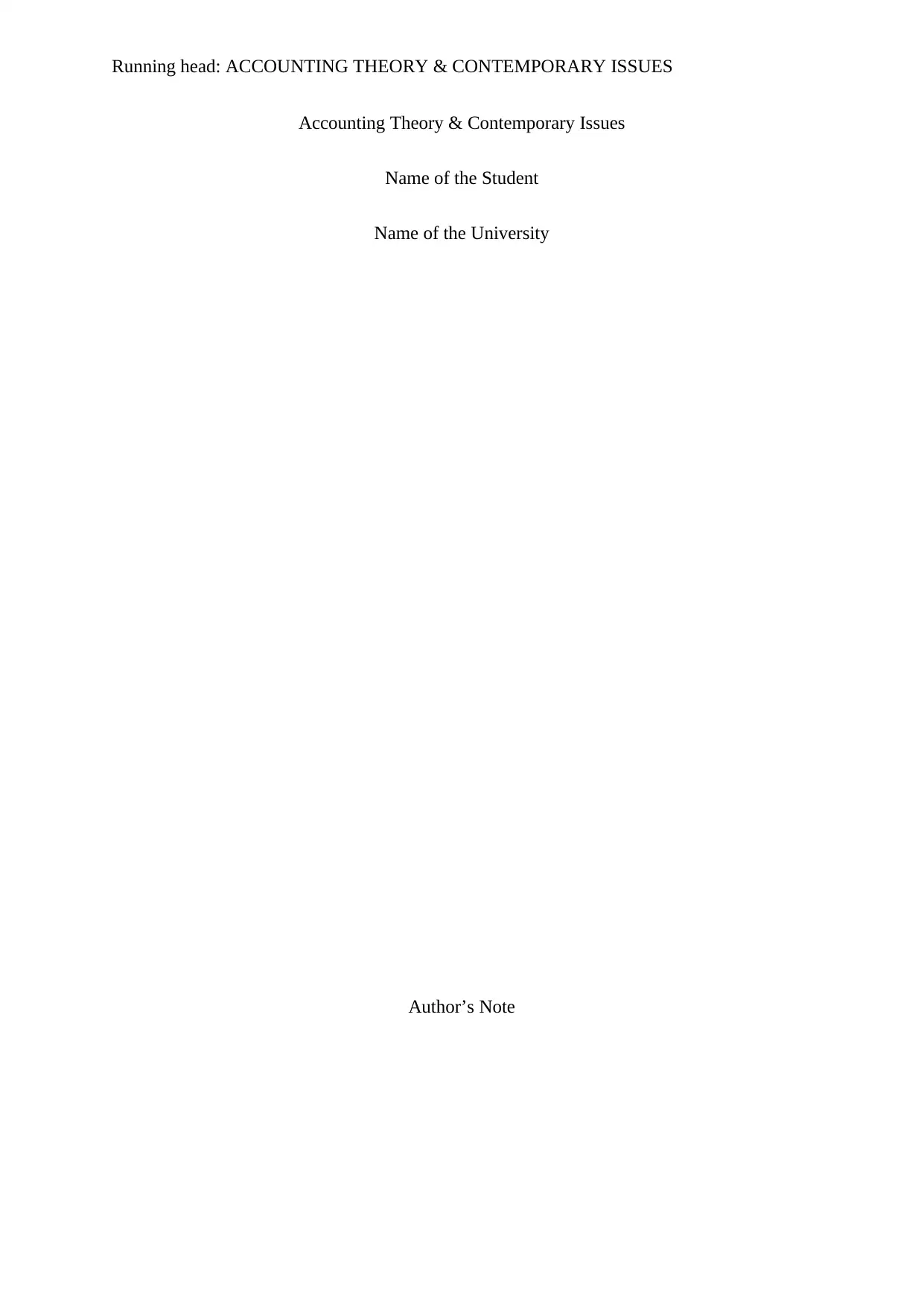
Running head: ACCOUNTING THEORY & CONTEMPORARY ISSUES
Accounting Theory & Contemporary Issues
Name of the Student
Name of the University
Author’s Note
Accounting Theory & Contemporary Issues
Name of the Student
Name of the University
Author’s Note
Paraphrase This Document
Need a fresh take? Get an instant paraphrase of this document with our AI Paraphraser
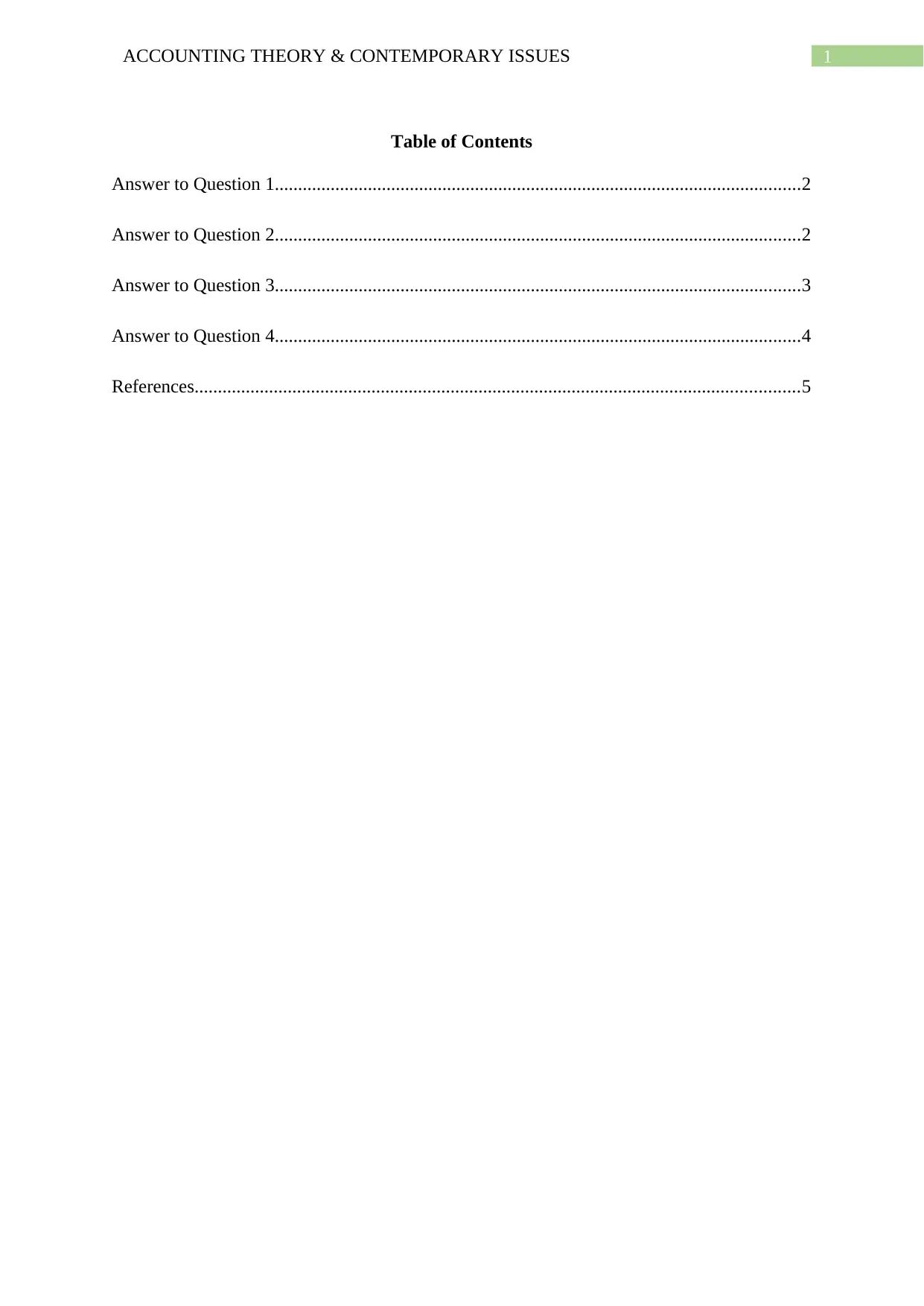
1ACCOUNTING THEORY & CONTEMPORARY ISSUES
Table of Contents
Answer to Question 1.................................................................................................................2
Answer to Question 2.................................................................................................................2
Answer to Question 3.................................................................................................................3
Answer to Question 4.................................................................................................................4
References..................................................................................................................................5
Table of Contents
Answer to Question 1.................................................................................................................2
Answer to Question 2.................................................................................................................2
Answer to Question 3.................................................................................................................3
Answer to Question 4.................................................................................................................4
References..................................................................................................................................5
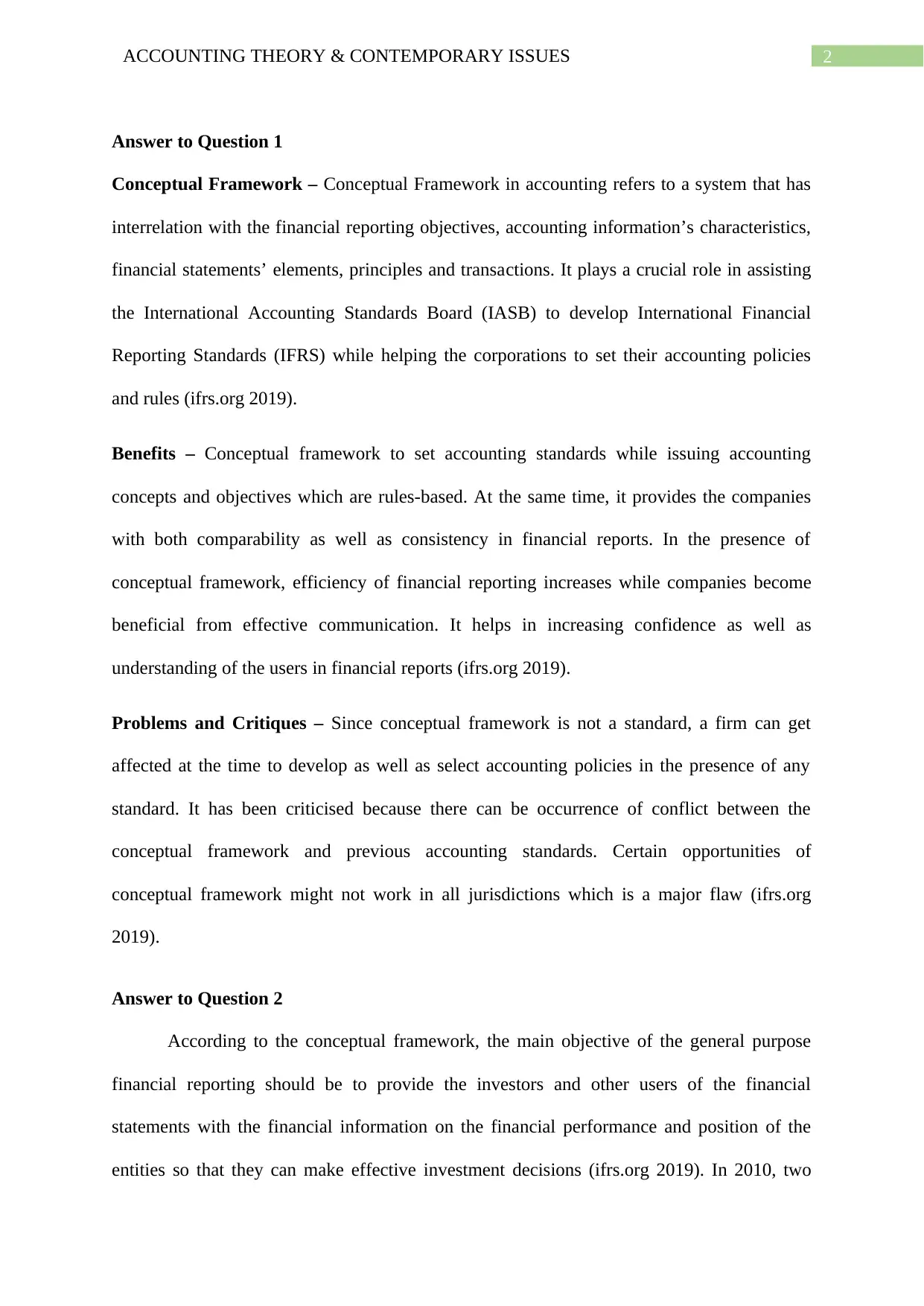
2ACCOUNTING THEORY & CONTEMPORARY ISSUES
Answer to Question 1
Conceptual Framework – Conceptual Framework in accounting refers to a system that has
interrelation with the financial reporting objectives, accounting information’s characteristics,
financial statements’ elements, principles and transactions. It plays a crucial role in assisting
the International Accounting Standards Board (IASB) to develop International Financial
Reporting Standards (IFRS) while helping the corporations to set their accounting policies
and rules (ifrs.org 2019).
Benefits – Conceptual framework to set accounting standards while issuing accounting
concepts and objectives which are rules-based. At the same time, it provides the companies
with both comparability as well as consistency in financial reports. In the presence of
conceptual framework, efficiency of financial reporting increases while companies become
beneficial from effective communication. It helps in increasing confidence as well as
understanding of the users in financial reports (ifrs.org 2019).
Problems and Critiques – Since conceptual framework is not a standard, a firm can get
affected at the time to develop as well as select accounting policies in the presence of any
standard. It has been criticised because there can be occurrence of conflict between the
conceptual framework and previous accounting standards. Certain opportunities of
conceptual framework might not work in all jurisdictions which is a major flaw (ifrs.org
2019).
Answer to Question 2
According to the conceptual framework, the main objective of the general purpose
financial reporting should be to provide the investors and other users of the financial
statements with the financial information on the financial performance and position of the
entities so that they can make effective investment decisions (ifrs.org 2019). In 2010, two
Answer to Question 1
Conceptual Framework – Conceptual Framework in accounting refers to a system that has
interrelation with the financial reporting objectives, accounting information’s characteristics,
financial statements’ elements, principles and transactions. It plays a crucial role in assisting
the International Accounting Standards Board (IASB) to develop International Financial
Reporting Standards (IFRS) while helping the corporations to set their accounting policies
and rules (ifrs.org 2019).
Benefits – Conceptual framework to set accounting standards while issuing accounting
concepts and objectives which are rules-based. At the same time, it provides the companies
with both comparability as well as consistency in financial reports. In the presence of
conceptual framework, efficiency of financial reporting increases while companies become
beneficial from effective communication. It helps in increasing confidence as well as
understanding of the users in financial reports (ifrs.org 2019).
Problems and Critiques – Since conceptual framework is not a standard, a firm can get
affected at the time to develop as well as select accounting policies in the presence of any
standard. It has been criticised because there can be occurrence of conflict between the
conceptual framework and previous accounting standards. Certain opportunities of
conceptual framework might not work in all jurisdictions which is a major flaw (ifrs.org
2019).
Answer to Question 2
According to the conceptual framework, the main objective of the general purpose
financial reporting should be to provide the investors and other users of the financial
statements with the financial information on the financial performance and position of the
entities so that they can make effective investment decisions (ifrs.org 2019). In 2010, two
⊘ This is a preview!⊘
Do you want full access?
Subscribe today to unlock all pages.

Trusted by 1+ million students worldwide
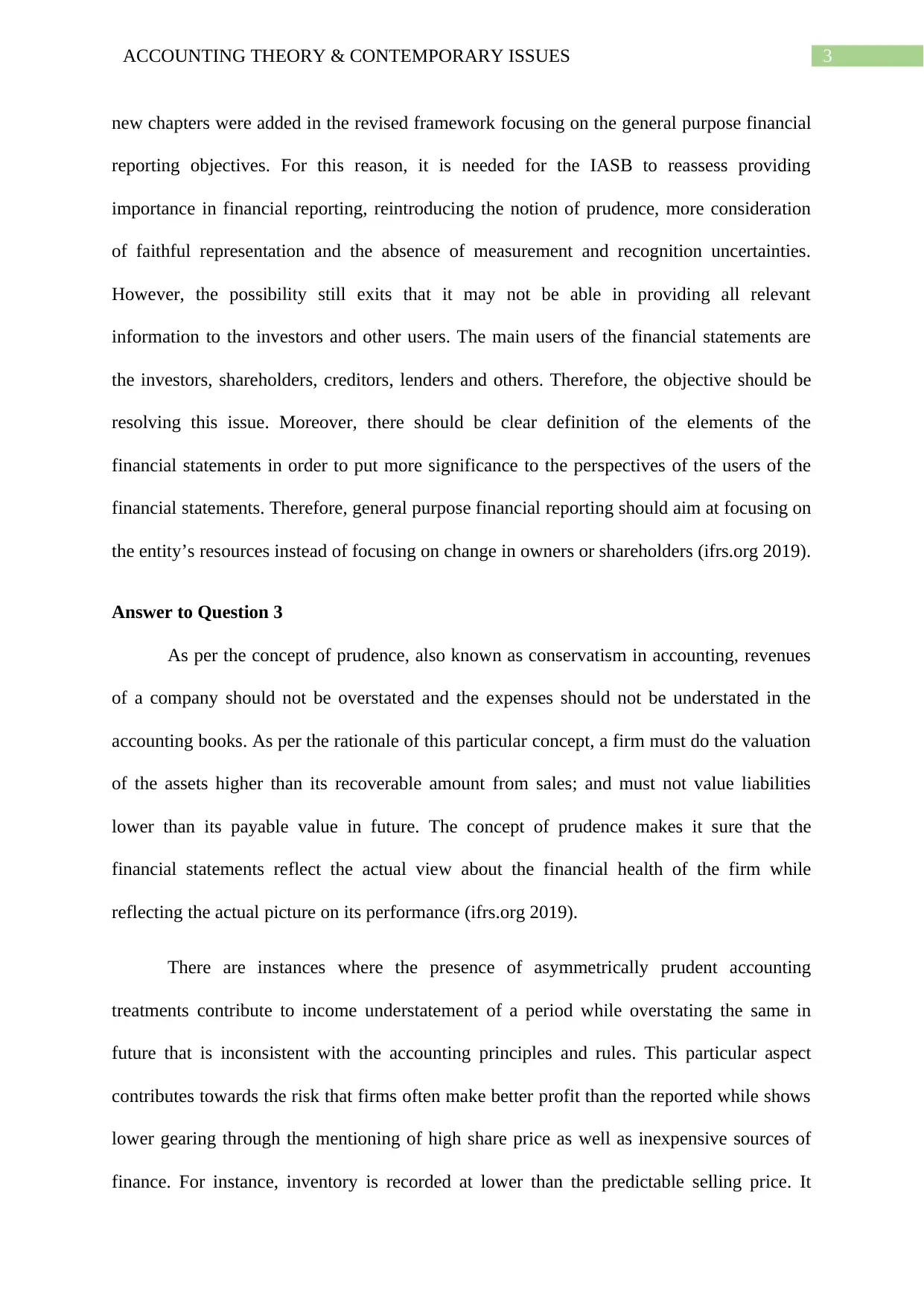
3ACCOUNTING THEORY & CONTEMPORARY ISSUES
new chapters were added in the revised framework focusing on the general purpose financial
reporting objectives. For this reason, it is needed for the IASB to reassess providing
importance in financial reporting, reintroducing the notion of prudence, more consideration
of faithful representation and the absence of measurement and recognition uncertainties.
However, the possibility still exits that it may not be able in providing all relevant
information to the investors and other users. The main users of the financial statements are
the investors, shareholders, creditors, lenders and others. Therefore, the objective should be
resolving this issue. Moreover, there should be clear definition of the elements of the
financial statements in order to put more significance to the perspectives of the users of the
financial statements. Therefore, general purpose financial reporting should aim at focusing on
the entity’s resources instead of focusing on change in owners or shareholders (ifrs.org 2019).
Answer to Question 3
As per the concept of prudence, also known as conservatism in accounting, revenues
of a company should not be overstated and the expenses should not be understated in the
accounting books. As per the rationale of this particular concept, a firm must do the valuation
of the assets higher than its recoverable amount from sales; and must not value liabilities
lower than its payable value in future. The concept of prudence makes it sure that the
financial statements reflect the actual view about the financial health of the firm while
reflecting the actual picture on its performance (ifrs.org 2019).
There are instances where the presence of asymmetrically prudent accounting
treatments contribute to income understatement of a period while overstating the same in
future that is inconsistent with the accounting principles and rules. This particular aspect
contributes towards the risk that firms often make better profit than the reported while shows
lower gearing through the mentioning of high share price as well as inexpensive sources of
finance. For instance, inventory is recorded at lower than the predictable selling price. It
new chapters were added in the revised framework focusing on the general purpose financial
reporting objectives. For this reason, it is needed for the IASB to reassess providing
importance in financial reporting, reintroducing the notion of prudence, more consideration
of faithful representation and the absence of measurement and recognition uncertainties.
However, the possibility still exits that it may not be able in providing all relevant
information to the investors and other users. The main users of the financial statements are
the investors, shareholders, creditors, lenders and others. Therefore, the objective should be
resolving this issue. Moreover, there should be clear definition of the elements of the
financial statements in order to put more significance to the perspectives of the users of the
financial statements. Therefore, general purpose financial reporting should aim at focusing on
the entity’s resources instead of focusing on change in owners or shareholders (ifrs.org 2019).
Answer to Question 3
As per the concept of prudence, also known as conservatism in accounting, revenues
of a company should not be overstated and the expenses should not be understated in the
accounting books. As per the rationale of this particular concept, a firm must do the valuation
of the assets higher than its recoverable amount from sales; and must not value liabilities
lower than its payable value in future. The concept of prudence makes it sure that the
financial statements reflect the actual view about the financial health of the firm while
reflecting the actual picture on its performance (ifrs.org 2019).
There are instances where the presence of asymmetrically prudent accounting
treatments contribute to income understatement of a period while overstating the same in
future that is inconsistent with the accounting principles and rules. This particular aspect
contributes towards the risk that firms often make better profit than the reported while shows
lower gearing through the mentioning of high share price as well as inexpensive sources of
finance. For instance, inventory is recorded at lower than the predictable selling price. It
Paraphrase This Document
Need a fresh take? Get an instant paraphrase of this document with our AI Paraphraser
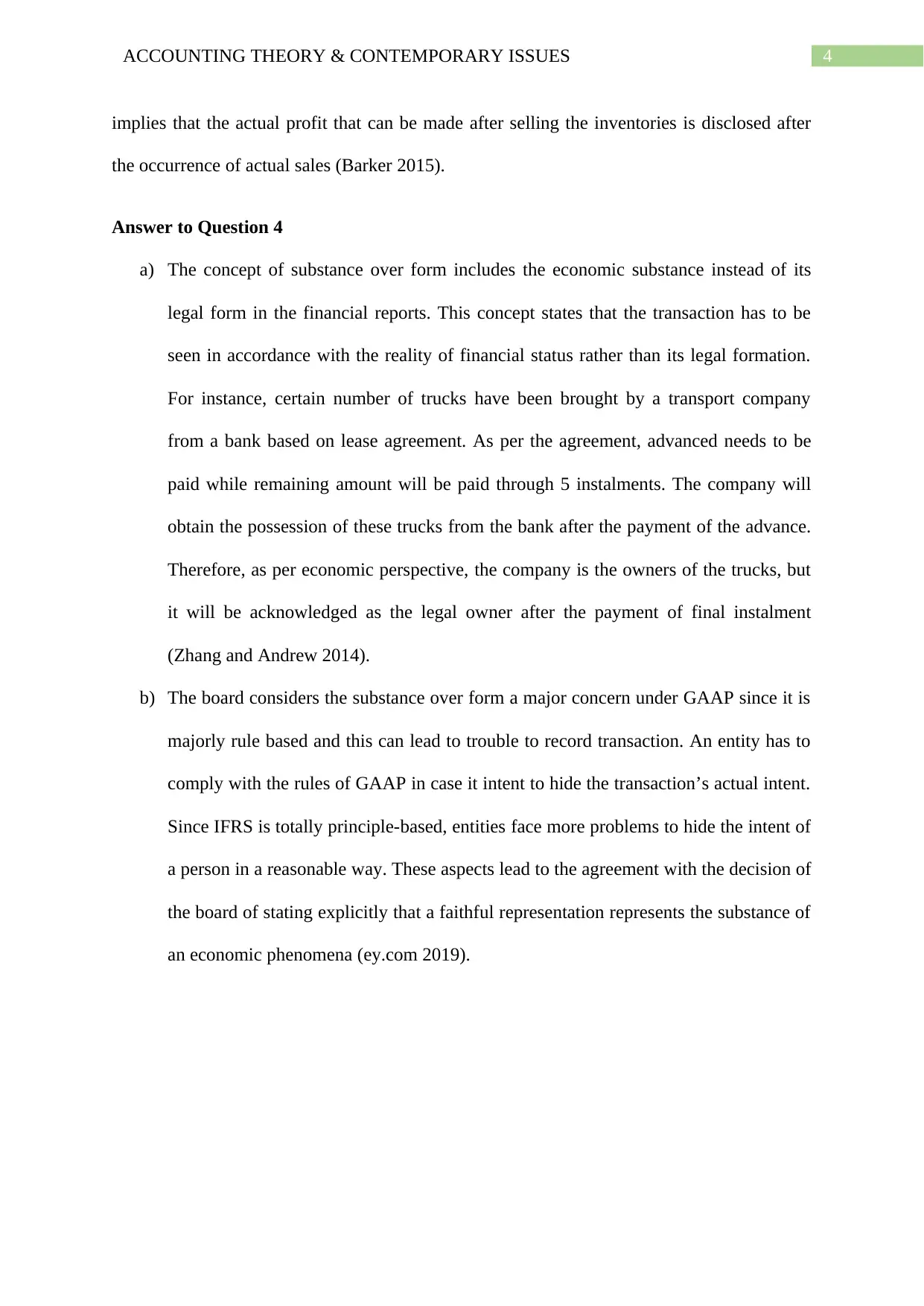
4ACCOUNTING THEORY & CONTEMPORARY ISSUES
implies that the actual profit that can be made after selling the inventories is disclosed after
the occurrence of actual sales (Barker 2015).
Answer to Question 4
a) The concept of substance over form includes the economic substance instead of its
legal form in the financial reports. This concept states that the transaction has to be
seen in accordance with the reality of financial status rather than its legal formation.
For instance, certain number of trucks have been brought by a transport company
from a bank based on lease agreement. As per the agreement, advanced needs to be
paid while remaining amount will be paid through 5 instalments. The company will
obtain the possession of these trucks from the bank after the payment of the advance.
Therefore, as per economic perspective, the company is the owners of the trucks, but
it will be acknowledged as the legal owner after the payment of final instalment
(Zhang and Andrew 2014).
b) The board considers the substance over form a major concern under GAAP since it is
majorly rule based and this can lead to trouble to record transaction. An entity has to
comply with the rules of GAAP in case it intent to hide the transaction’s actual intent.
Since IFRS is totally principle-based, entities face more problems to hide the intent of
a person in a reasonable way. These aspects lead to the agreement with the decision of
the board of stating explicitly that a faithful representation represents the substance of
an economic phenomena (ey.com 2019).
implies that the actual profit that can be made after selling the inventories is disclosed after
the occurrence of actual sales (Barker 2015).
Answer to Question 4
a) The concept of substance over form includes the economic substance instead of its
legal form in the financial reports. This concept states that the transaction has to be
seen in accordance with the reality of financial status rather than its legal formation.
For instance, certain number of trucks have been brought by a transport company
from a bank based on lease agreement. As per the agreement, advanced needs to be
paid while remaining amount will be paid through 5 instalments. The company will
obtain the possession of these trucks from the bank after the payment of the advance.
Therefore, as per economic perspective, the company is the owners of the trucks, but
it will be acknowledged as the legal owner after the payment of final instalment
(Zhang and Andrew 2014).
b) The board considers the substance over form a major concern under GAAP since it is
majorly rule based and this can lead to trouble to record transaction. An entity has to
comply with the rules of GAAP in case it intent to hide the transaction’s actual intent.
Since IFRS is totally principle-based, entities face more problems to hide the intent of
a person in a reasonable way. These aspects lead to the agreement with the decision of
the board of stating explicitly that a faithful representation represents the substance of
an economic phenomena (ey.com 2019).
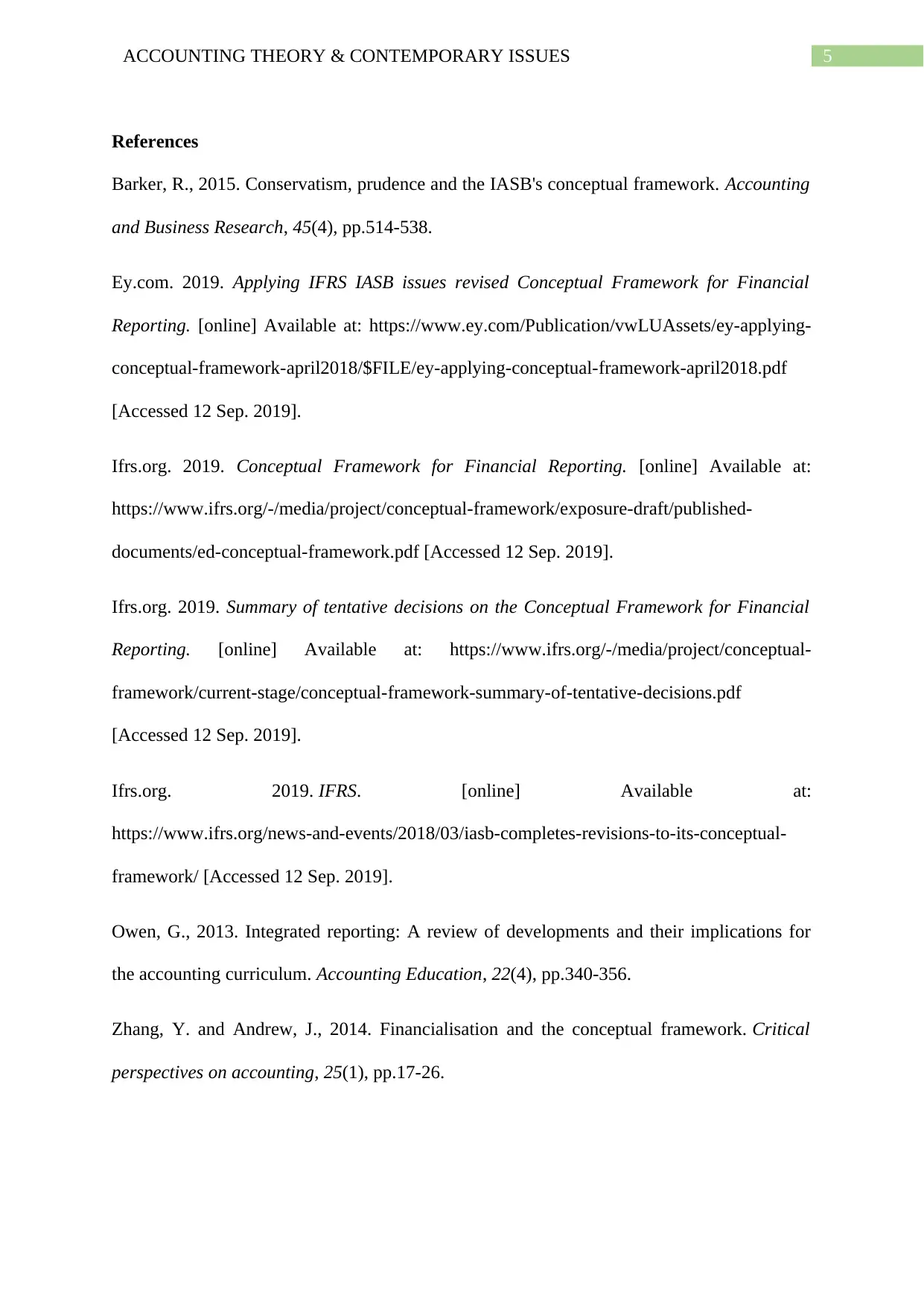
5ACCOUNTING THEORY & CONTEMPORARY ISSUES
References
Barker, R., 2015. Conservatism, prudence and the IASB's conceptual framework. Accounting
and Business Research, 45(4), pp.514-538.
Ey.com. 2019. Applying IFRS IASB issues revised Conceptual Framework for Financial
Reporting. [online] Available at: https://www.ey.com/Publication/vwLUAssets/ey-applying-
conceptual-framework-april2018/$FILE/ey-applying-conceptual-framework-april2018.pdf
[Accessed 12 Sep. 2019].
Ifrs.org. 2019. Conceptual Framework for Financial Reporting. [online] Available at:
https://www.ifrs.org/-/media/project/conceptual-framework/exposure-draft/published-
documents/ed-conceptual-framework.pdf [Accessed 12 Sep. 2019].
Ifrs.org. 2019. Summary of tentative decisions on the Conceptual Framework for Financial
Reporting. [online] Available at: https://www.ifrs.org/-/media/project/conceptual-
framework/current-stage/conceptual-framework-summary-of-tentative-decisions.pdf
[Accessed 12 Sep. 2019].
Ifrs.org. 2019. IFRS. [online] Available at:
https://www.ifrs.org/news-and-events/2018/03/iasb-completes-revisions-to-its-conceptual-
framework/ [Accessed 12 Sep. 2019].
Owen, G., 2013. Integrated reporting: A review of developments and their implications for
the accounting curriculum. Accounting Education, 22(4), pp.340-356.
Zhang, Y. and Andrew, J., 2014. Financialisation and the conceptual framework. Critical
perspectives on accounting, 25(1), pp.17-26.
References
Barker, R., 2015. Conservatism, prudence and the IASB's conceptual framework. Accounting
and Business Research, 45(4), pp.514-538.
Ey.com. 2019. Applying IFRS IASB issues revised Conceptual Framework for Financial
Reporting. [online] Available at: https://www.ey.com/Publication/vwLUAssets/ey-applying-
conceptual-framework-april2018/$FILE/ey-applying-conceptual-framework-april2018.pdf
[Accessed 12 Sep. 2019].
Ifrs.org. 2019. Conceptual Framework for Financial Reporting. [online] Available at:
https://www.ifrs.org/-/media/project/conceptual-framework/exposure-draft/published-
documents/ed-conceptual-framework.pdf [Accessed 12 Sep. 2019].
Ifrs.org. 2019. Summary of tentative decisions on the Conceptual Framework for Financial
Reporting. [online] Available at: https://www.ifrs.org/-/media/project/conceptual-
framework/current-stage/conceptual-framework-summary-of-tentative-decisions.pdf
[Accessed 12 Sep. 2019].
Ifrs.org. 2019. IFRS. [online] Available at:
https://www.ifrs.org/news-and-events/2018/03/iasb-completes-revisions-to-its-conceptual-
framework/ [Accessed 12 Sep. 2019].
Owen, G., 2013. Integrated reporting: A review of developments and their implications for
the accounting curriculum. Accounting Education, 22(4), pp.340-356.
Zhang, Y. and Andrew, J., 2014. Financialisation and the conceptual framework. Critical
perspectives on accounting, 25(1), pp.17-26.
⊘ This is a preview!⊘
Do you want full access?
Subscribe today to unlock all pages.

Trusted by 1+ million students worldwide
1 out of 6
Related Documents
Your All-in-One AI-Powered Toolkit for Academic Success.
+13062052269
info@desklib.com
Available 24*7 on WhatsApp / Email
![[object Object]](/_next/static/media/star-bottom.7253800d.svg)
Unlock your academic potential
Copyright © 2020–2025 A2Z Services. All Rights Reserved. Developed and managed by ZUCOL.





